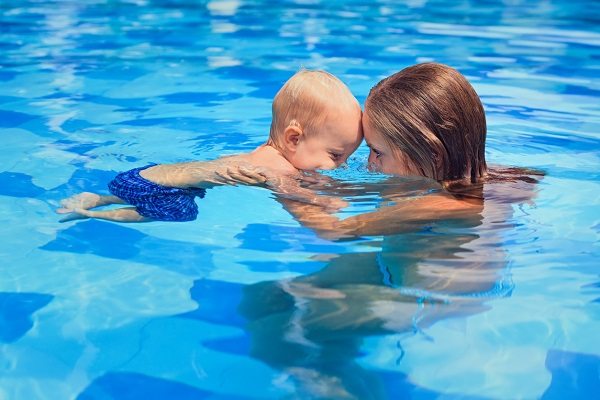While new mothers should be careful when getting into chlorinated pools with fresh wounds from vaginal or Caesarean births, there’s no reason your baby can’t enjoy a little dip with their daddies or even grannies and grandads! Even the HSE agrees that it’s never too early to start swimming with your baby.
Babies can get into the pool before being vaccinated as the diseases they are immunised against are not carried in water.
However, some parents may (very understandably) want to get their bearings for those first few weeks before embarking on their first (of many!) trips to the pool. Here’s what you need to know about bringing your baby swimming!
Why bring my baby swimming?
You or your partner has just given birth. Your baby is sleeping at irregular intervals and you’ve only just mastered the art of a visit to your mother’s house, let alone to a public pool. What are the incentives to take on a swimming trip?
Water safety – Studies show that children who are introduced to water earlier in life are less nervous around it later on. Early swimming can help children learn life saving techniques such as floating on their back.
Encourage physical and mental health – Swimming helps to develop strength and conditioning in muscles by providing gentle resistance to movements. Going for a swim also boosts self esteem and endorphin levels which leaves your body feeling sated and happy!
Promotes bonding through skin to skin contact – Babies love the touch of their parents whether it’s through massage, stroking their hands or feet or just holding them close! When parents hold their babies, skin to skin, their brains send messages of ‘I’m safe’ all around their body, allowing them to relax and observe what they are seeing, feeling and hearing.
Develops learning skills – Being in the water engages your baby’s body in a totally unique way; creating thousands of new neurons as your baby kicks, glides and smacks at the water. This full bodied engagement increases your baby’s intelligence in later life by creating bi-lateral cross-pattern movements (using both sides of the body to carry out an action) which down the road improves reading, language skills and spatial awareness.
Provides structure – For older children, the structure of going swimming once a week helps to provide a routine as well as something for them to look forward to.
What will I need?
Like most things, swimming with the addition of a baby means a few extra things have to be brought along.
- Reusable swim nappies – imperative. Accidents can happen at any moment.
- A warm bottle for after the swim if you are bottle feeding – all that exercise makes your baby hungry!
- A towel with a hood or a towel dressing gown for your baby.
- A few of your baby’s bath toys to create a fun, relaxed atmosphere.
- Changing mat and nappy bag.
Beginners’ tips
- Check your local pool’s temperature and ask them when would be the best time to swim with your baby. Babies should bathe in water that is around 32 degrees Celsius.
- Start off with short session of about ten minutes long. Your baby will get colder quicker than you, so make sure they get warm and dry all over once out of the pool.
- Join a parent-baby swim class when you’re starting out. This will help you to build confidence as well as meet other parents in similar situations.
- Check with your local pool for busiest times, and ask when would be the best time to come with your baby.
For information on parent and baby swim classes in your area read here!
maternity&infant
Originally posted 2017-10-24 10:26:12.

